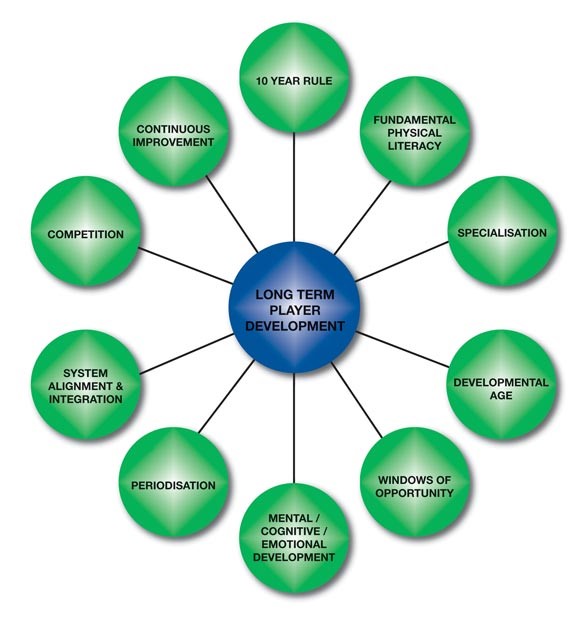Long term athlete development (LTAD)
The Long Term Athlete Development Pathway was originally proposed and introduced, not only to rugby but also to other sports, through the work and influence of Dr Istvan Balyi of Canada’s National Coaching Institute during the 1990s. Today, the LTAD model proposed by Balyi and colleagues has become one of the main templates for guiding coaches and administrators in developing the technical, tactical and physical competencies to better prepare players for the game (Balyi et al, 2005). The template is not a rigid prescriptive model, but rather it can be viewed as a set of guidelines that emphasises at all times the importance of a player-centred approach. The LTAD model is based on a set of 10 key principles (Balyi et al, 2005). They are illustrated in the figure below.

All of these principles are important in their own right and provide a foundation for the LTAD model. Explaining all these principles in detail is beyond the scope of this introductory module but there are some key considerations to comprehend.
Firstly, coaches must appreciate that it takes time to develop a player to his or her potential. The 10-year rule implies that frequent and regular practice is central to fulfilling one’s potential. However, this should not be viewed as an essential requirement for those who wish to participate in the game of rugby. Rather, it is a guide for those who may seek to reach their true potential within a given sport.
The second key principle relates to the importance of ensuring that the player has fun and enjoys developing and advancing the fundamental movement skills and the basic technical skills of the game.
The third key principal is that early specialisation for the player is likely to be problematic as it may blunt important fundamental movement skills development and possibly lead to burnout and overtraining of the player. As a result, children should be encouraged to play many different sports at this stage to benefit their development.
Finally, coaches should appreciate the social context in which the player is taking part in the game. Added to this awareness is the importance of recognising the mental/cognitive and emotional stages of development that occur through the different stages of the player’s development pathway.